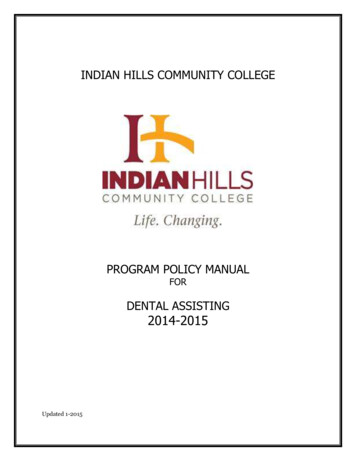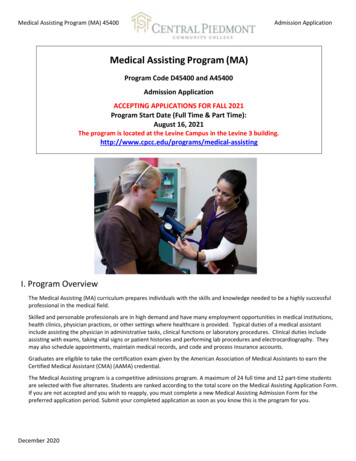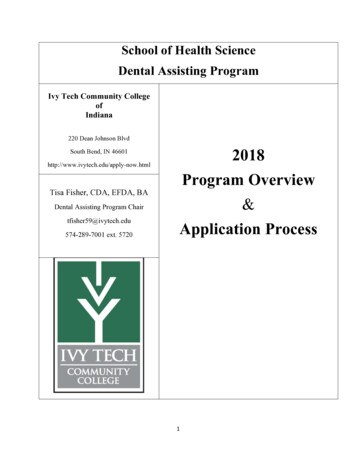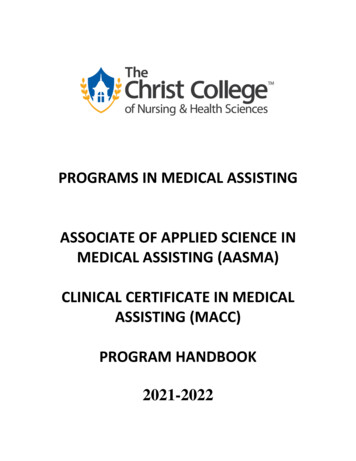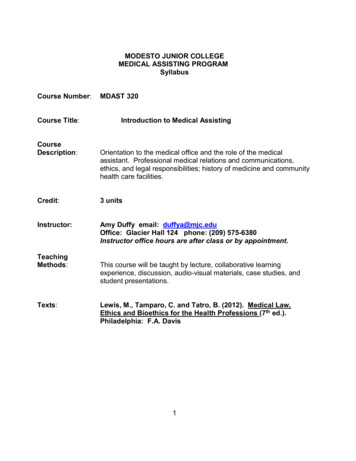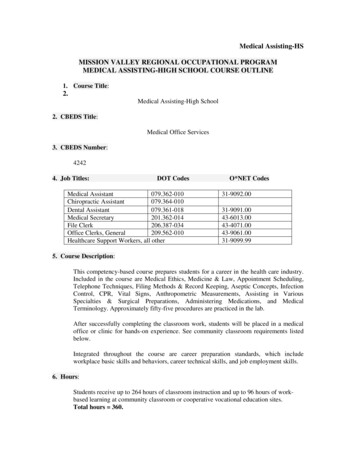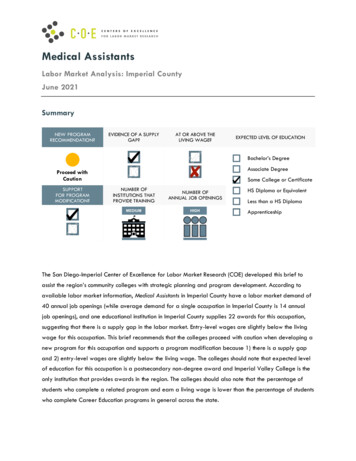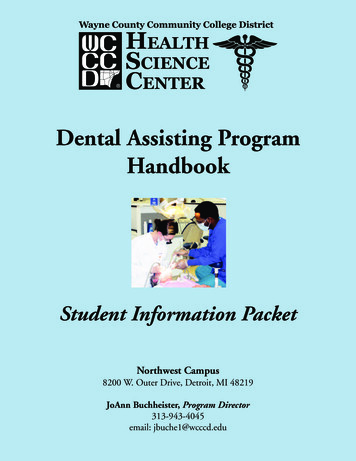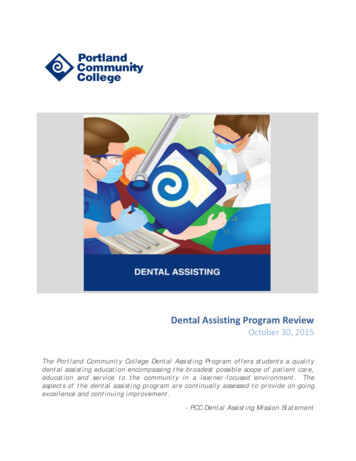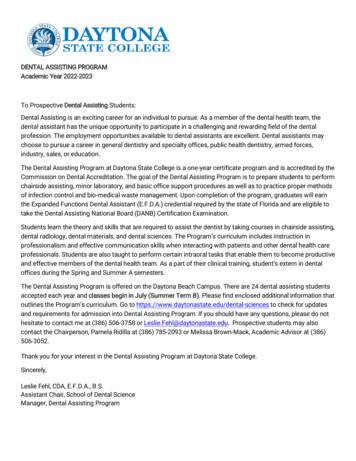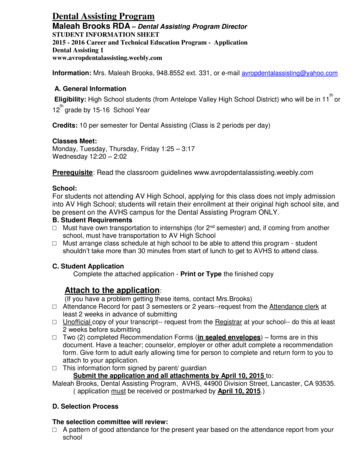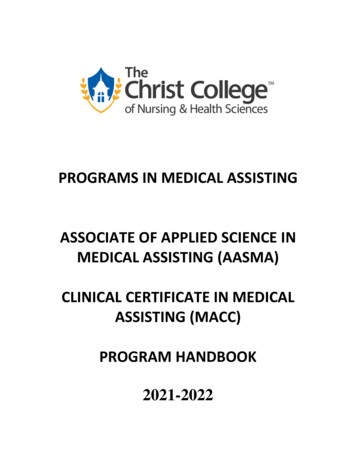
Transcription
PROGRAMS IN MEDICAL ASSISTINGASSOCIATE OF APPLIED SCIENCE INMEDICAL ASSISTING (AASMA)CLINICAL CERTIFICATE IN MEDICALASSISTING (MACC)PROGRAM HANDBOOK2021-2022
To the Medical Assisting Student:Welcome to The Christ College of Nursing and Health Sciences! We are excited about the opportunityto partner with you as you begin your educational journey within the profession of medical assisting(MA).The MA Program Handbook is an important document to guide you through and promote yoursuccessful completion of the program. Please read the document thoroughly and familiarize yourselfwith the policies, procedures, and regulations within the MA Program Handbook. The faculty,professional staff, and administration are available to assist you with policies, procedures, or regulationsin the MA Program Handbook as necessary.Occasionally it is necessary to introduce new or revise existing policies, procedures, or regulations in theMA Program Handbook. New policies and revisions will be posted on the College’s electronic learningmanagement system.As you begin your journey, we encourage you to interact with your class peers and faculty members tohelp enhance and diversify your learning opportunities. Together we can enrich the culture of medicalassisting through caring, collaboration, integrity, and excellence!Best wishes for success in your educational endeavors!Sincerely,Faculty, Staff, and AdministrationThe Christ College of Nursing and Health SciencesDepartment of Health Sciences2
FOREWORDThe Christ College of Nursing and Health Sciences College Catalog and Associate of Applied Science,Medical Assisting (MA) Program/Medical Assisting Clinical Certificate Handbook are guidebooks for ourstudents in the MA program.It is the responsibility of each student to know the contents of both documents and to respect andmaintain the rules and standards of the College and the Department of Health Sciences.The College and Department of Health Sciences reserve the right to change any provision or policy in theinterest of the College, MA program, or students.The MA Program Handbook can be accessed through the College’s electronic learning managementsystem.PLEASE NOTEThe Christ College of Nursing and Health Sciences is committed to a policy of nondiscrimination on the basis of race, color, creed, national origin, citizenship, religion, ethnicity,age, gender, gender identity, genetics, marital status, sex, pregnancy, sexual orientation,military or veteran status, disability, or any other status protected by local, state or federal law(collectively, “protected statuses”) in the administration of its educational, recruitment, andadmissions policies; scholarship and loan programs; and athletic or other Collegeadministered programs. All institutional processes and policies follow applicable federal andstate laws and regulations related to discrimination.3
Introduction to the Medical Assisting ProgramThe Associate of Applied Science in Medical Assisting Degree (AASMA) and Medical Assisting ClinicalCertificate (MACC)) program at The Christ College of Nursing and Health Sciences provides a course ofstudy that integrates concepts from arts and sciences into a medical assisting curriculum emphasizingacademic excellence, professionalism, and clinical competence. The AASMA program is a 16-month, 4semester program which requires a 160 Practicum at an assigned ambulatory clinic. This programprepares the medical assistant to perform duties in the front and back office and requires a total of 60credit hours of both medical assisting and health sciences curriculum to meet the requirements forcompletion.The Medical Assistant Clinical Certificate (MACC) program at The Christ College of Nursing and HealthSciences is a 16-week, 1 semester certificate program that integrates clinical medical assistingcurriculum emphasizing academic excellence, professionalism, and clinical competency. The programfocuses on back office medical assisting competencies only. This program requires a total of 16 clinicalcredit hours for completion. Students in this program are not required to complete a Practicumassignment.Note: All Occupations includes all occupations in the U.S. EconomySource: U.S. Bureau of Labor Statistics, Employment Projections program.Employment of medical assistants is projected to grow 29 percent from 2016 to 2026, much faster thanthe average for all occupations. The growth of the aging baby-boom population will continue to increasedemand for preventive medical services, which are often provided by physicians. As a result, physicianswill hire more assistants to perform routine administrative and clinical duties, allowing the physicians tosee more patients.An increasing number of group practices, clinics, and other healthcare facilities will also need supportworkers, particularly medical assistants, to complete both administrative and clinical duties. Medicalassistants work mostly in primary care, a steadily growing sector of the healthcare industry.Medical assistants are expected to have good job prospects; however, those who earn certification andhave familiarity with electronic health records (EHRs) may have better job prospects.Publish Date: April 12, 2019 Revised May 20, istants.htm#tab-6Development of the Educational Competencies for the MedicalAssistant.The Associate of Applied Science in Medical Assisting Degree (AASMA) and Medical Assisting ClinicalCertificate (MACC)) and the Clinical Certificate Medical Assisting (MACC) program incorporates the4
educational competencies for the Medical Assistant which are aligned with the 2015 standards asoutlined by the Medical Assistant Educational Review Board (MAERB) and Commission on Accreditationof Allied Health Education Programs (CAAHEP).Administrative duties: (AASMA only)(The following outlines administrative duties that may be taught during the program) Greeting patients and familiesScheduling appointmentsUsing computer applicationsEntering and maintaining data in EHR systemAnswering telephonesUpdating and filing patient medical recordsCoding, billing and filling out insurance formsArranging for hospital admissions and laboratory servicesClinical duties: (AASMA & MACC)(Clinical duties vary by state, but may include) Taking vital signsObtaining medical historiesExplaining treatment procedures to patients within scope of Medical AssistantPreparing patients for examinationAssisting the provider (physician or advanced practice practitioner) during the examinationCollecting and preparing laboratory specimensPerforming basic laboratory testsInstructing patients about medication and special dietsPreparing and administering medications as directed by a providerInjections and vaccinationsAuthorizing prescription refills ad directedObtaining Prior Authorizations before proceduresDrawing blood (Venipuncture/Capillary)Taking electrocardiogramsRemoving sutures and changing dressings5
Table of ContentsIntroduction to the Medical Assisting Program . 4Development of the Educational Competencies for the Medical Assistant. . 4Administrative duties: (AASMA only) . 5Clinical duties: (AASMA & MACC) . 5(Clinical duties vary by state, but may include) . 5Philosophy . 8INSTITUTIONAL LEARNING OUTCOMES . 9Program Description . 9Program goals and objectives: . 9Goals: . 9Objectives: . 10Program Outcomes: . 10Medical Assisting Professional Program Curriculum: . 11Program Sequence AASMA . 11Core Curriculum and Curriculum Plan Revised . 11Program Sequence MACC . 13Medical Assistant Program Course Descriptions: . 13Course Descriptions: . 13BIO 102: Structure & Function of the Body . 13COM 112: Professional Communication & Behavior for Medical Assisting Professionals . 13ENG 101: English Composition . 13FYE 102: Learning Foundations . 14HCA 101: Medical Terminology. 14MA 100: Pharmacology for the Medical Assistant Professional . 14MA 102: Legal and Ethical Issues for Medical Assisting Professionals . 14MA 200: Diagnostic Procedures for Medical Assisting Professionals . 14MA 201: Administrative Procedures for Medical Assisting Professionals . 15MA 204: medical Insurance/Coding and Financial Business Practices for the Medical Assistant . 15MA 206: Clinical Review & Medical Emergency Procedures for the Medical Assisting Professional. 15MA 207: Clinical Review & Medical Emergency Procedures for the Medical Assistant Professional. 156
MA 209: Career Development Capstone for Medical Assisting Professionals . 15MAT 102 – Quantitative Reasoning . 15TECH 101: Basic Technology Skills and Applications . 15Program Grading Scale: . 16Acceptance into the Medical Assisting Professional program: . 16Academic Advising: . 16Medical Assisting Professional Program Standards: . 17Behaviors of Accountability . 17Student Code of Conduct: . 17Classroom Conduct (Face/Online): . 17Four Professional Impressions Domains: . 17First Impression Domain: . 18Second Impression Domain: . 18Third Impression Domain:. 18Fourth Impression Domain: . 18Dress Code: . 18Practicum: (AASMA only) . 20Community Service: . 20Academic Integrity and Honesty:. 20Equipment and Lab Maintenance: . 21Program Attendance: . 21Classroom Scheduling: . 21Inclement Weather/Cancellations:. 22Scheduled Exams: . 22Pop Quizzes: . 22Lab/Competency: . 22Practicum/Clinical Policy:. 22Health Requirements: . 22Physical Examination . 22Drug Screening . 22Health Screening and Immunization Requirements . 23Protection from Blood Borne Pathogen Infections: . 23Medical Situations . 257
Medical Releases . 25Student Injury . 25Health Services/Emergency Procedures:. /operations/#college-emergency-procedures. 26Disciplinary Standards and Procedures: . 26Grievances and Appeals: . 27Disability Compliance: . 27Program Completion: . 27American Association of Medical Assistants/Certification (AAMA): . 27CMA Code of Conduct/Certification: February 2018 . 27CMA Standards: . 27I. Grounds for denial of eligibility for the CMA (AAMA) credential, or for discipline of the CMA(AAMA) . 27II. Expired credentials . 28III. Procedures for adjudicating alleged violations of Disciplinary Standards. 28IV. Possible sanctions . 29Miscellaneous Information/Policies and Procedures: . 29APPENDIX A – MAERB Core Curriculum for Medical Assistants . 30Student Handbook Verification Form . 43PhilosophyA person is a unique individual having intrinsic value. Everyone has diverse physical, emotional, social,developmental, and spiritual needs in varying degrees of fulfillment and deserves caring interventions.The person and environment are constantly interacting.The environment includes all internal and external factors affecting and affected by the individual. Apart of this dynamic environment is society, which consists of individuals, families, communities, andinstitutions. Any change in the environment may require varying degrees of adaptation. Health Sciencesgraduates engage in assessment of both the environment and people to identify opportunities topromote, maintain, or restore health.8
Health is the dynamic process of balance and harmony within the person, including physical, mental,and social well-being. A person’s state of health is influenced by personal, societal, and cultural variablesand may be affected by prevention and treatment strategies.The Arts and Sciences curriculum at The Christ College of Nursing and Health Sciences serves to developwithin students certain intellectual and cognitive capacities, habits of mind and character, values, moralawareness, integrative abilities in connecting bodies of knowledge, and qualities necessary forproductive citizenship in an open and vibrant democracy.INSTITUTIONAL LEARNING OUTCOMESAs a result of their educational experiences at The Christ College students will:1. Apply an expanded knowledge base within one’s chosen profession and demonstrate acommitment to pursuing additional learning opportunities related to academic, personal, orprofessional interests.2. Demonstrate responsible engagement with social-political-cultural issues of local, regional, orglobal significance.3. Demonstrate academic and professional competency in written and oral communication.4. Demonstrate academic and professional competency within the sciences.5. Demonstrate an ability to engage in intellectual inquiry and apply critical thinking throughidentifying assumptions, making inferences, marshaling evidence, and giving a coherent accountof reasoning.Program DescriptionThe Associate of Applied Science in Medical Assisting Degree program provides a course of study with afoundation in the Arts and Sciences emphasizing academic excellence, professionalism, and clinicalcompetence. The promotion of critical thinking skills, professional behaviors, and self-directed learningprepares graduates as medical assistants to work collaboratively in dynamic ambulatory health caresettings with a diversity of cultures. The completion of the Associate of Applied Science in MedicalAssisting Degree makes it possible for graduates to take the Medical Assisting Certification examinationand to pursue more advanced educational pathways.The Clinical Certificate in Medical Assisting program provides a course of study with a foundation in theclinical skills, emphasizing academic excellence, professionalism, and clinical competence. Thepromotion of critical thinking skills, professional behaviors, and self-directed learning preparesgraduates as back office medical assistants to work collaboratively in the dynamic ambulatory healthcare settings with a diversity of cultures. The completion of the Certificate in Medical Assisting makes itpossible for graduates to take the Medical Assisting Clinical Certification examination and to pursuemore advanced educational pathways.Program goals and objectives:Goals:1. To prepare competent entry-level medical assistant professionals in the cognitive (knowledge),psychomotor (skills), and affective (behavior) learning domains.9
2. To maintain a Medical Assisting program consistent with the guidelines and standards of theCommission for Accreditation of Allied Health Education Programs (CAAHEP), with Ohio statuesand regulations for The Christ College of Nursing and Health Sciences.3. To remain up-to-date and current with the changing healthcare industry.4. To provide programs and resources for students, college, and community to provide a programthat meets the needs of healthcare and the communities that we serve.Objectives:1. Maintain awareness of changes in the healthcare field and instructional/educational arena byreviewing literature, publications, and attending seminars that are health related.2. Review and revise the Medical Assisting curriculum on a regular basis at minimum annually.3. Review and revise the Medical Assisting program course syllabi on a regular basis at minimumannually.4. Facilitate scheduled meetings of the Medical Assisting Professional Advisory Committee to gaininformation on local health care updates and changes to incorporate this into the program’scurriculum.5. Visit and survey practicum sites to gain input into the strengths and/or weaknesses of theMedical Assisting program and incorporate as necessary this information into the AdvisoryCommittee and into curriculum review.6. Maintain an active professional development program to ensure staff are abreast and current inhealth care and in education and instruction.Program Outcomes:A graduate of the Associate of Applied Science in Medical Assisting Degree program and the ClinicalCertificate in Medical Assisting at The Christ College of Nursing and Health Sciences will be able to:1. Perform at a competent entry-level medical assistant in the cognitive (knowledge), psychomotor(skills), and affective (behavior) learning domains.2. Demonstrate professional communication while interacting with providers, staff, and patients.3. Perform professional administrative and clinical skills in the delivery of quality patient care, AASMAonly.4. Maintain ethical and legal behavior within the scope of practice for Medical Assistant.10
5. Discuss the value of lifelong learning and continuing education.The learning outcomes are successfully completed through cognitive, psychomotor, and affectivecompetencies by demonstrating the following:1. Communication: The Medical Assistant Professional graduate communicates effectively with patients,supervisors, support personnel, and other health care team members using suitable verbal, nonverbal,and written skills.2. Analytical Skills: The Medical Assistant Professional graduate applies knowledge of basic sciences andmedical theory to the application and appropriate modification of administrative and clinical medicalassisting procedures. (Administrative skills apply in AASMA only)3. Citizenship: The Medical Assistant Professional graduate possesses the necessary professionalbehaviors to practice as a medical assistant in a variety of practice settings.4. Critical and Creative Thinking: The Medical Assistant Professional graduate applies critical/creativethinking and analytical skills to make sound administrative and clinical judgments to enhance patientcare. (Administrative skills apply to AASMA only)5. Cultural Heritage and Literacy: The Medical Assistant Professional graduate delivers patient care in arespectful manner that reflects sensitivity to individual differences.6. Concentration in Medical Assisting: The Medical Assistant Professional graduate possesses thenecessary entry level administrative and clinical skills to practice as a medical assistant in a variety ofpractice settings. (Administrative skills apply to AASMA only)7. Certification in Medical Assisting: The Medical Assistant Professional graduate is successful inqualifying to sit for certification/registration with a national certifying organization.Medical Assisting Professional Program Curriculum:The Christ College of Nursing and Health Sciences AASMA program & MACC were developed utilizingrecommendations from The Medical Assisting Education Review Board (MAERB). EducationalCompetencies for a Medical Assistant (ECMA), provide entry-level competencies found in thepsychomotor and affective domains as identified in the Commission on Accreditation of Allied HealthEducation Programs (CAAHEP), and Standards and Guidelines for Medical Assisting EducationalPrograms 2008 Standards).Educational Curriculum/Competencies see Appendix A page 30 of this handbook for a document titled“Core Curriculum for Medical Assistants”. This document is prepared by the Medical Assisting EducationReview Board (MAERB), and the Medical Assisting programs incorporates the knowledge base, skills, andbehavior competencies into the curriculum.Program Sequence AASMACore Curriculum and Curriculum Plan Revised11
Year andSemesterFr. I (15)ENG 101MAT 102HCA 101BIO 102FYE 102Fr. II (15)COM 112TECH 101MA 100MA 102MA 104Soph. I(16)MA 200MA 201MA 204MA 206MA 208Soph. II(14)MA 209PSY/SOCHUMElectiveCourse TitleFall (2 nights)English CompositionQuantitative ReasoningMedical TerminologyStructure & Function of the BodyLearning FoundationsSpring (4 nights)Professional Communication & Behavior forMedical Assisting ProfessionalsBasic Technology Skills and ApplicationsonlinePharmacology for the Medical AssistantProfessionalLegal and Ethical Issues for MedicalAssisting ProfessionalsFoundations for Clinical for the MedicalAssistant 1F-2-F20online31F-2-F31F-2-FSummer (4 nights)Diagnostic Procedures for Medical AssistingProfessionalsAdministrative Procedures for the MedicalAssistant (formerly 202 & 203)Medical Insurance/Coding & FinancialBusiness Practice for the Medical Assistant(formerly 205)Clinical Reviews and Medical EmergencyProcedures for the Medical Assistant(formerly 207) – Co-Requisite MA 104Academic Appraisal for the ProfessionalMedical Assistant (new course)Fall (days)Career Development Capstone for MedicalAssisting d213.5333F-2-Fonline4.5F-2-Fonlineonlineonline12
Total Number of credits in the program 60Program Sequence MACCSemesterCredits(16)BIO 102BIO 160MA 104MA 200MA 206Course line31F-2-F31F-2-F21F-2-F124Fall – Spring - SummerStructure & Function of the BodyFood and FitnessFoundations for Clinical Medical AssistantProfessionalDiagnostic Procedures for Medical AssistingProfessionalsClinical Reviews and Medical EmergencyProcedures for the Medical Assistant(formerly 207) – Co-Requisite MA 104Total Number of credits in the program 16Medical Assistant Program Course Descriptions:Course Descriptions:BIO 102: Structure & Function of the BodyThis course introduces the students to a basic understanding of anatomy and physiology of the humanbody. The course also describes the structural and functional relationships among the organ systems.COM 112: Professional Communication & Behavior for Medical Assisting ProfessionalsThis course focuses on communication skills and behavior expected of the professional medical assistantin all healthcare settings.ENG 101: English CompositionEnglish Composition 101 fosters development of critical reading, writing and thinking skills that areimportant to academic and professional success and satisfaction. Through reading, discussing and writingabout rich and complex texts (mainly nonfiction prose), students will learn how critical reading, open and13
unbiased discussion, and effective writing are closely interrelated skills, strengthening each andexperiencing the value of each for the other. Students will become more perceptive readers and morearticulate and aware
Medical Assisting (MA) Program/Medical Assisting Clinical Certificate Handbook are guidebooks for our students in the MA program. It is the responsibility of each student to know the contents of both documents and to respect and maintain the rules and standards of the College and the Department of Health Sciences.
